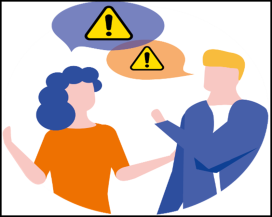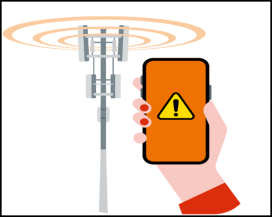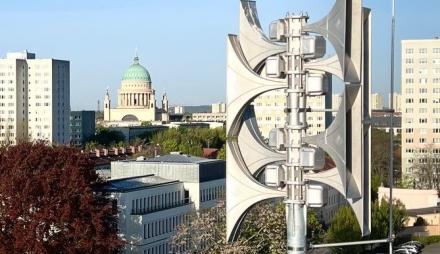
Extreme weather conditions, major fires, hazardous substances or safety-relevant events - in an emergency, every minute counts. To ensure that you are warned quickly and reliably, the Potsdam fire brigade operates a multi-level warning system in cooperation with state and federal authorities - the so-called warning mix.
The aim is to reach everyone in the city in a timely, reliable and targeted manner - regardless of location or time of day.
On this page you can find out:
- When are warnings issued in Potsdam?
- How are warnings and information issued in Potsdam?
- Sirens, warning apps, cell broadcast - three warning methods in detail.
- How do you react correctly in an emergency?
- Where can you find further information?
If you prefer the German version of this article, please click the button DE on the right. // Sollten Sie die deutsche Version dieses Artikels bevorzugen, klicken Sie bitte den Button DE auf der rechten Seite.
Summary of the public warning in Potsdam
Weather, major fires, hazardous substances or safety-related events - every minute counts in an an emergency. To ensure that you are warned promptly, Potsdam relies on a so-called warning mix: a multi-stage system that combines traditional and modern warning tools to reach as many people as possible quickly and reliably - regardless of location or time of day.
The most important warning tools include sirens, warning apps (such as NINA and KATWARN) and cell broadcasting. Sirens warn with standardised nationwide signal tones: a rising and falling wailing tone (1 minute) means acute danger - seek shelter, close windows and doors, switch on the radio or warning app and help others. A constant continuous tone (1 minute) signifies the all-clear. Further siren signals are used to alert the fire department or as a test alarm. You can find a detailed explanation of the siren warning system in the following section.
Warning apps provide location-based push notifications, behavioural advice and additional information - also in several languages. They are free, ad-free and easy to use.
Cell Broadcast sends warnings directly as text messages to all mobile phones in the danger zone that are ready to receive them - without an app, registration or location sharing.
In case of emergency: Take the warning seriously. Stay calm. Use official channels (radio, television, warning apps, and government websites) to get advice about the protective measures you should follow. Only call 112 in an emergency. Wait for the official all-clear.
To ensure that you are prepared in an emergency, it is advisable to get familiar with the available warning systems and recommendations for action in advance. You may start in the following section. - Because the best protection is good preparation.

When are warnings issued in Potsdam?
A warning is issued to the population in the event of a specific or imminent threat to life, health, public safety or supply. This would be, for example
- Fires or explosions with the development of smoke/hazardous substances
- Heavy rain, storms, flooding or other extreme weather
- Technical faults (e.g. power outages, water supply)
- Danger from explosive ordnance (e.g. bomb disposal)
- Dangerous situations (e.g. amok, terror)
- Civil defence
The responsible authorities decide whether a warning is necessary and through which channels it is issued depending on the situation. Not all available warning means are necessarily used at the same time - the type and scope of the warning depends on the specific danger situation.
In Potsdam - as throughout Germany - warnings are issued in accordance with the standardised warning levels of the federal government in the event of a crisis in order to inform the population quickly, uniformly and comprehensibly about dangerous situations.
These are as follows:
1st level Extreme Danger
- Acute, life-threatening situation, e.g. explosion, flood or large-scale power failure. Act immediately, move to safety, take warnings seriously.
2nd stage Danger Warning
- The danger is concrete and can threaten life and limb. Now is the time: Follow instructions, seek shelter, have emergency supplies ready.
3rd level Hazard Information
- Early indication of a possible hazard, e.g. a storm or power failure. The aim is to raise awareness and enable initial precautionary measures to be taken.
All-clear
- When the danger has passed, an all-clear is given. This signals the situation: The acute threat is over, there is no longer an immediate risk.
Would you like to find out more about this?
Unfortunately, most of the information is only available in German. We hope that you will still find the information you need. If not, please feel free to contact us.
BBK – aktuelle Warnmeldungen in der Übersicht
BBK – Wann und wovor warnen deutsche Behörden?
How are warnings and information issued in Potsdam?

The state capital of Potsdam relies on a multi-level warning mix that combines various technical channels in a targeted manner. This diversity is a key strength of the nationwide warning system: it ensures that warning messages reach as many people as possible - even if individual channels such as mobile phones, television or radio fail or are not recognised.
The technical basis is the Modular Warning System of the Federal Government (MoWaS). It enables authorities at federal, state and municipal level to disseminate official warnings and all-clear messages simultaneously via various channels.
The channels used include sirens, warning apps such as NINA and KATWARN, cell broadcasting, digital city information boards, radio stations and official websites. This interplay of complementary warning tools significantly increases the range and reliability: the more channels are used in parallel, the higher the probability that the population will receive a warning message in good time.
Disaster control lighthouses (KatS-Lt) serve as central contact points for warning and informing the population in the event of a crisis, particularly in the event of a blackout. They enable official situation information to be passed on, emergency calls to be made and contact to be maintained with the authorities, even if regular means of communication fail. In this way, they ensure a reliable warning function and support the population's own precautions. Further information and an overview of the locations in Potsdam can be found here.
IMPORTANT:
Official warning messages are also broadcast via radio, television and the internet. In order for this information to be received, a functioning power supply is usually required - or a battery or crank-powered radio.
Please note: It may take a few minutes for broadcasters to integrate the warnings transmitted via the Modular Warning System (MoWaS) into the current programme. In acute danger situations, the programme is usually interrupted to read out the warning message. All-clear messages are also passed on in this way. The same applies to messages on the Internet.
In addition, the warning mix enables different forms of communication: sirens generate immediate attention in the surrounding area, while apps, radio or television provide specific information and initial behavioural advice. Some warning devices are visual, others are audible or haptic - such as the vibration alarm on a smartphone. This variety is crucial, especially in the first few seconds of a dangerous situation, so that those affected are warned and informed quickly, comprehensibly and effectively.
Would you like to find out more about this?
Unfortunately, most of the information is only available in German. We hope that you will still find the information you need. If not, please feel free to contact us.
ISF Bund-Länder-Projekt Warnung der Bevölkerung – Modulares Warnsystem
ISF Bund-Länder-Projekt Warnung der Bevölkerung – Warnkanäle
Sirens, warning apps, cell broadcast - three warning methods in detail.
The city of Potsdam uses several technical warning tools to reliably reach the population in the event of an emergency. Three central components of the warning system are sirens, warning apps and cell broadcast. They differ in terms of technology and effect - and complement each other.
Sirens - classic warning device with current significance

Sirens are a central element of public warning in Germany - including in Potsdam. They produce an acoustic signal that can be heard from afar and thus directly and immediately address all people in the vicinity - even when they are asleep or have switched off their mobile phones. This is known as the wake-up effect. Sirens remain highly relevant, especially when other warning devices fail. The wailing sounds of sirens indicate a danger or the end of a danger. However, the people warned must then obtain information about the background to the warning from other trustworthy sources.
To get familiar with the most important two sounds, you can check out the WARNING SOUND and ALL-CLEAR SOUND.

Would you like to find out more about this?
Unfortunately, most of the information is only available in German. We hope that you will still find the information you need. If not, please feel free to contact us.
ISF Bund-Länder-Projekt Warnung der Bevölkerung – Modulares Warnsystem
ISF Bund-Länder-Projekt Warnung der Bevölkerung – Warnkanäle
rbb – Was tut der rbb im Katastrophenfall?
Warning apps - modern warning tools with great potential

Modern warning apps are a useful addition to traditional warning tools and reach many people directly on their smartphones - with pinpoint accuracy and in real time. Two central applications in Germany are NINA and KATWARN. Both apps can be installed and used in parallel as they complement each other.
Warning app NINA
The warning app NINA (Federal Emergency Information and News App) is provided by the Federal Office of Civil Protection and Disaster Assistance (BBK). It provides reliable information about:
- Population warnings from control centres and disaster control authorities
- Severe weather warnings from the German Weather Service (DWD)
- Flood information from the relevant state authorities
NINA sends push notifications for the current location as well as additionally selected locations. Important behavioural tips, emergency information and links to further information are also included. NINA can also issue warnings in Arabic, English, French, Polish, Russian, Spanish and Turkish. NINA is free of charge and ad-free - available for Android and iOS.
KATWARN warning app
The KATWARN app is used by local authorities, districts and companies. It supplements NINA with additional, locally issued warnings - for example for events, environmental hazards or technical faults in individual regions. KATWARN also sends location-based alerts directly to mobile phones and can be used free of charge - available for Android and iOS.
The wailing sounds of sirens indicate a danger or the end of a danger. However, the people warned must then obtain information about the background to the warning from other trustworthy sources.
Would you like to find out more about this?

Unfortunately, most of the information is only available in German. We hope that you will still find the information you need. If not, please feel free to contact us.
Cell Broadcast – warning directly to your mobile phone

Cell Broadcast is a technical warning system that sends official warning messages directly to mobile phones - without an app, without registration and without location sharing. The message appears automatically as a text message on the display, accompanied by a special warning signal and vibration alarm.
Cell Broadcast works via mobile phone masts and reaches all compatible mobile phones that are located in a specific danger zone. The warning is sent specifically to the affected radio cells - so only people in this area receive the information. The service is anonymous, uses no mobile data and works even when the network is heavily utilised.
In Germany, Cell Broadcast has been an integral part of the warning system since February 2023. To receive warnings, the device must be technically suitable and the Cell Broadcast function must be activated. Most modern smartphones (from Android 11 and iOS 16.1) support the service. Users should ensure that all system updates are installed and the corresponding settings are activated.
Further information and technical advice:
Unfortunately, most of the information is only available in German. We hope that you will still find the information you need. If not, please feel free to contact us.
Cell Broadcast – Empfangsfähige Geräte
Would you like to find out more about this?
Unfortunately, most of the information is only available in German. We hope that you will still find the information you need. If not, please feel free to contact us.
How do you react correctly in an emergency?

In an emergency, every second counts. If you receive a warning, it is important to act quickly and correctly to ensure your safety and that of others.
Please observe the following basic rules:
- Take the official warning seriously.
- Keep calm.
- Act in a calm and informed way by following the official warnings. These will inform you about protective measures to be taken in case of doubt.
- Only dial 112 in an emergency.
- Wait for the official all-clear.
Important
Take the opportunity to familiarise yourself with the BBK's recommendations. These include advice on emergency preparedness and the correct behaviour in emergency situations.
Would you like to find out more about this?
Unfortunately, most of the information is only available in German. We hope that you will still find the information you need. If not, please feel free to contact us.
BBK – Tipps für Notsituationen
BBK – Für den Notfall vorsorgen
BBK – Ratgeber für Notfallvorsorge und richtiges Handeln in Notsituationen
Where can you find further information?
In the event of an emergency, warning messages are available via many channels in German. Some warning tools - in particular the NINA warning app - also offer multilingual information. In the event of major emergencies, the Federal Office of Civil Protection and Disaster Assistance (BBK) provides additional behavioural instructions in several languages, for example in English, French, Arabic, Russian or Turkish.
Please note that not all warning messages are automatically available in other languages. As a rule, the primary language remains German. It is therefore advisable to learn the basic terms and behavioural instructions in advance.
Would you like to find out more about this?
ISF-Project – NINA warn app
BBK – Guide for Emergency Preparedness and Correct Action in Emergency Situations

Legal notice
The external links recommended on this page to offers from federal and state authorities and third parties have been carefully selected. The state capital of Potsdam accepts no responsibility for their content, availability or topicality. Please note the respective data protection declarations and terms of use of the external providers.


